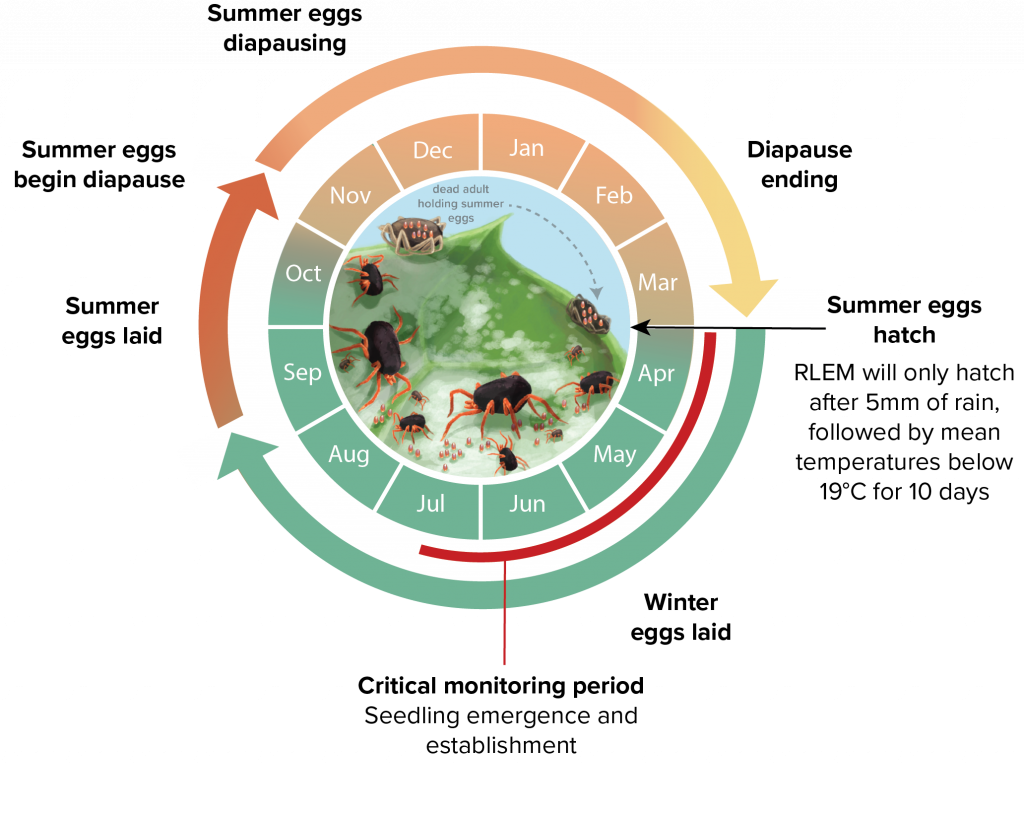Limiting the number of diapause eggs produced in spring can help reduce redlegged earth mite numbers in high risk paddocks the following year. In this article we explain when and how Timerite should be used as part of an effective redlegged earth mite management strategy.
Importance of reducing diapause eggs
The redlegged earth mite (Halotydeus destructor) is a common and widespread pest of pastures and most broadacre crops.
In summer, these mites exist as diapause eggs (in a state of suspended development) to avoid the heat and lack of food. These eggs hatch when cool, wet conditions arrive in autumn.
Diapause eggs are extremely tough, enabling the local mite population to persist into the next winter growing season. They can also be picked up by dust storms during summer, which will transport eggs to new locations.
Limiting the number of diapause eggs produced during spring is an important component of ongoing management of redlegged earth mite in high-risk paddocks.

How do I know my risk?
There are several factors to consider when predicting whether the redlegged earth mite will be a problem in a paddock.
Examples of high-risk situations heading into next season include:
- Paddock is currently legume dominant pasture, medic or canola
- Next season planting will be legume dominant pasture or canola
- Broadleaf weeds (particularly capeweed) are common in the paddock, or at the paddock edges
- If a pasture paddock, the canopy is dense, creating an ideal environment for mites
- Redlegged earth mite has been common in the paddock
The severity risk for a given paddock can be calculated using the assessment tool featured in the ‘Redlegged earth mite: best management practice guide’ available for download through the GRDC website.
Recently, the team at Cesar Australia has developed an online, interactive risk calculator based on this best management practice guide.
Use the calculator to predict your risk.
Reducing paddock risk
Since the redlegged earth mite is evolving resistance to insecticides across Australia, and targeted sprays are often broad-spectrum insecticides which disrupt beneficial natural enemies, it’s important not to rely on annual, routine spraying.
Ways to reduce risk without spraying include avoiding sowing highly susceptible crops (e.g. canola) into pastures or paddocks known to contain high mite numbers, and where practical, rotating paddocks with non-preferred crops (e.g. chickpeas and lentils). Undertaking weed management (particularly broadleaf weeds) or heavy pasture grazing in spring can also help to reduce mite numbers the following autumn.
If sowing susceptible crops in higher risk paddocks in 2022, early sowing can help to avoid damage because plants will be established by the time the redlegged earth mites hatch.
Using Timerite® to maximise spray effectiveness
If you do have a paddock that is at risk, you may need to consider management actions in spring to prevent high numbers of redlegged earth mite next season.
Timerite® is a tool which uses environmental data (primarily day length) to predict when diapause eggs are likely to be produced in spring.
The tool provides a location specific date for when spraying should occur (if necessary). This gives growers a window of opportunity to strategically target redlegged earth mite-problem paddocks.
Optimum dates for redlegged earth mite control in eastern Australia are mostly between mid-September to mid-October. Exact dates are available through the Timerite model.
The date for spring spraying is unique to each property and remains constant from year to year. It is recommended that spraying be carried out within the two-week period before the optimal date.
Some examples of the recommended dates are:
- Birchip VIC – 14 September
- Horsham VIC – 23 September
- Bendigo VIC – 28 September
- Wagga Wagga NSW – 29 September
- Cootamundra NSW – 14 October
- Benalla VIC –12 October
- Hamilton VIC – 15 October
It is important to note that Timerite® is not designed for other pasture and crop mites such as blue oat mites, Bryobia mites and Balaustium mites, and will not be effective against these species. Correct identification of mites is a critical first step before considering if Timerite® is appropriate this spring.
If you have experienced redlegged earth mite, we want to hear from you!
Cesar Australia are asking growers and advisors to complete a short survey (less than 10 mins) which will help us improve on-farm management strategies aimed at minimising resistance issues in redlegged earth mites.
Take the survey here
Acknowledgements
Thank you to Paul Umina for contributions to this article
Cover image: Photo by Andrew Weeks, Cesar Australia





